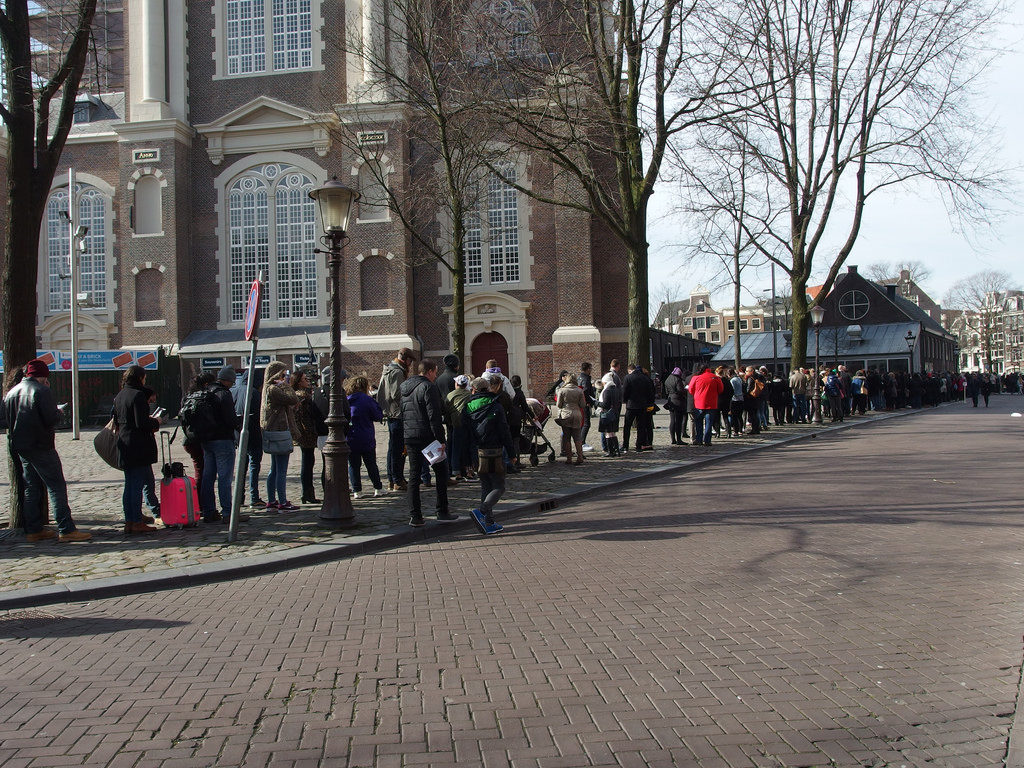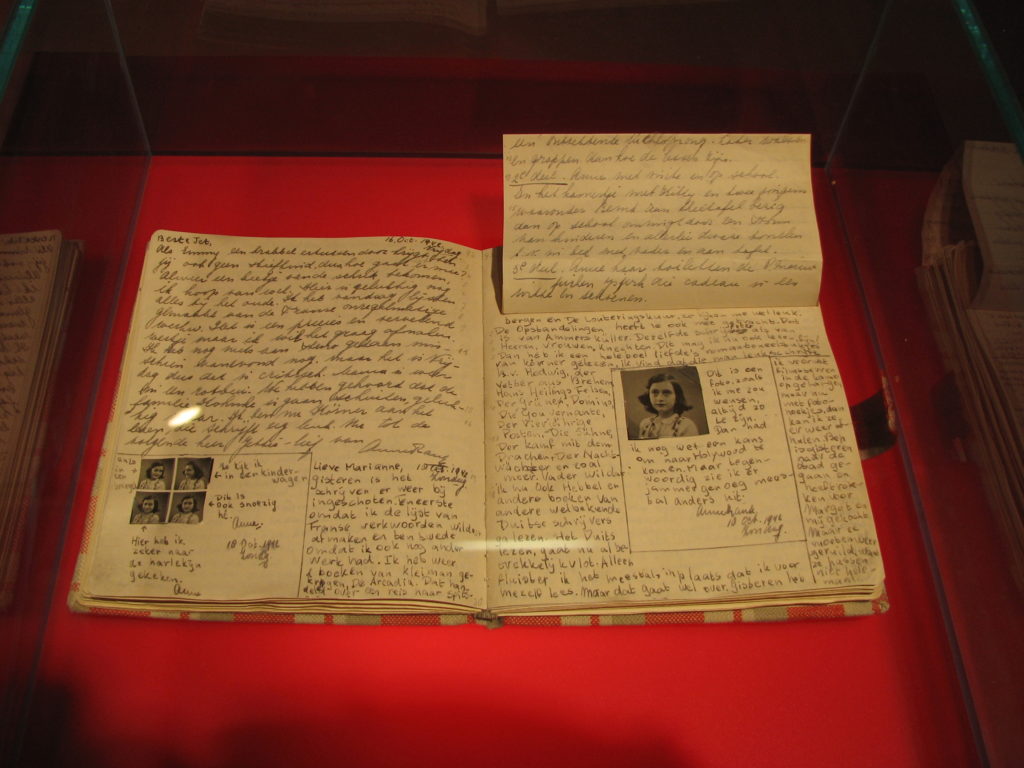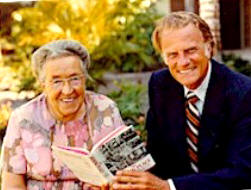To return to Blog Post Intro, click here.
Anne Frank

About a month before our trip, we looked into getting tickets to the Anne Frank museum. Unfortunately, they were sold out, but we learned that you could stand in line (like the picture above), and tickets would be released at 3:30 in the afternoon. We got in line about 2:30 in the afternoon and entered the house by 4:30, finishing our tour at 5:30. It was a particularly moving experience.
Here’s her story (from the U.S. Holocaust Memorial Museum’s Web Site):
After the Nazi seized power in 1933, Otto Frank fled to Amsterdam in the Netherlands; and his family followed shortly after. Anne was the last to arrive in February 1934 after staying with her grandparents.
The Germans occupied Amsterdam in May 1940. In July 1942, German authorities and their Dutch collaborators began to concentrate Jews from throughout the Netherlands at Westerbork, a town not far from the German border.
During the first half of July 1940, Anne and her family went into hiding in an apartment which would eventually hide four Dutch Jews as well. For two years, they lived in a secret attic apartment behind the office of the family-owned business at 263 Prinsengracht Street, which Anne referred to in her diary as the Secret Annex. Otto Frank’s friends and colleagues had helped to prepare the hiding place and smuggled food and clothing to the Franks at great risk to their own lives.
On August 4, 1944, the Gestapo (German Secret State Police) discovered the hiding place after being tipped off by an anonymous Dutch caller and arrested the Franks. The Gestapo sent them to Westerbork on August 8. One month later, in September 1944, SS and police authorities placed the Franks, and the four others hiding with them, on a train transport from Westerbork to the Auschwitz camp complex in German-occupied Poland. Selected for labor due to their youth, Anne and her sister, Margot were transferred to the Bergen-Belsen concentration camp in northern Germany in late October 1944. Both sisters died of typhus five months later, just a few weeks before British troops liberated Bergen-Belsen on April 15, 1945.
Anne Frank’s Diary

Of the millions of children who suffered persecution at the hands of the Nazis, only a small number wrote diaries and journals that have survived. In these accounts, the young writers documented their experiences, confided their feelings, and reflected on the trauma they endured during these nightmare years.
While in hiding, Anne kept a diary in which she recorded her fears, hopes, and experiences. Found in the secret apartment after the family was arrested, the diary was kept for Anne by one of the people who helped hide the Franks. Anne’s diary was published after the war in many languages and is used in thousands of middle school and high school curricula in Europe and the Americas. Anne Frank has become a symbol for the lost promise of the children who died in the Holocaust.
Corrie Ten Boom

We were excited about the opportunity to tour the Corrie Ten Boom museum. We had reservations for this one, which was a good thing since they only allow 20 on each of four tours during the day!
Jennifer and I both read The Hiding Place on the flight from Houston to Amsterdam, so the story was fresh for us. Here’s Corrie’s story as told from her museum’s web site:
In 1837, Willem ten Boom opened a watch shop on Barteljorisstraat 19, Haarlem, Holland. His family lived in the rooms above the shop. The home was later passed down to Willem’s son, Casper, and then to Casper’s daughter, Corrie. In 1987 the Corrie ten Boom House Foundation purchased the building and opened it as a museum, often called the Hiding Place–an inspiring story and symbol that surpasses national boundaries.
The Ten Boom family were devoted Christians who dedicated their lives in service to their fellow man. Their home was always an “open house” for anyone in need. Through the decades the Ten Booms were very active in social work in Haarlem, and their faith inspired them to serve the religious community and society at large.
During the Second World War, the Ten Boom home became a refuge, a hiding place, for fugitives and those hunted by the Nazis. By protecting people, Casper and his daughters, Corrie and Betsie, risked their lives. This non-violent resistance against the Nazi-oppressors was the Ten Booms’ way of living out their Christian faith. This faith led them to hide Jews, students who refused to cooperate with the Nazis, and members of the Dutch underground resistance movement.
During 1943 and into 1944, there were usually 6-7 people illegally living in this home: 4 Jews and 2 or 3 members of the Dutch underground. Additional refugees would stay with the Ten Booms for a few hours or a few days until another “safe house” could be located for them. Corrie became a ringleader within the network of the Haarlem underground. Corrie and “the Beje group” would search for courageous Dutch families who would take in refugees, and much of Corrie’s time was spent caring for these people once they were in hiding. Through these activities, the Ten Boom family and their many friends saved the lives of an estimated 800 Jews, and protected many Dutch underground workers.
On February 28, 1944, this family was betrayed and the Gestapo (the Nazi secret police) raided their home. The Gestapo set a trap and waited throughout the day, seizing everyone who came to the house. By evening about 30 people had been taken into custody! Casper, Corrie and Betsie were all arrested.
Although the Gestapo systematically searched the house, they could not find what they sought most. They suspected Jews were in the house, but the Jews were safely hidden behind a false wall in Corrie’s bedroom. In this “hiding place” were two Jewish men, two Jewish women and two members of the Dutch underground. Although the house remained under guard, the Resistance was able to liberate the refugees 47 hours later. The six people had managed to stay quiet in their cramped, dark hiding place for all that time, even though they had no water and very little food. The four Jews were taken to new “safe houses,” and three survived the war. One of the underground workers was killed during the war years, but the other survived.
Because underground materials and extra ration cards were found in their home, the Ten Boom family was imprisoned. Casper (84 years old) died after only 10 days in prison. When Casper was asked if he knew he could die for helping Jews, he replied, “It would be an honor to give my life for God’s ancient people.” Corrie and Betsie spent 10 months in three different prisons, the last was the infamous Ravensbruck Concentration Camp located near Berlin, Germany. Life in the camp was almost unbearable, but Corrie and Betsie spent their time sharing Jesus’ love with their fellow prisoners. Many women became Christians in that terrible place because of Corrie and Betsie’s witness to them. Betsie (59) died in Ravensbruck, but Corrie survived.
After Corrie came home from the death camp, she realized her life was a gift from God, so she needed to share what she and Betsie had learned in Ravensbruck: “There is no pit so deep that God’s love is not deeper still” and “God will give us the love to be able to forgive our enemies.” At age 53, Corrie began a world-wide ministry which took her into more than 60 countries in the next 33 years! She testified to God’s love and encouraged all she met with the message that “Jesus is Victor.”

Corrie received many tributes. Corrie was knighted by the Queen of Holland. In 1968, the Holocaust Museum in Jerusalem asked Corrie to plant a tree in the Garden of Righteousness, in honor of the many Jewish lives her family saved. Corrie’s tree stands there today.
In the early 1970’s Corrie’s book The Hiding Place became a best seller and World Wide Pictures released the major motion picture “The Hiding Place.” Corrie went on to write many other inspiring books and make several evangelical videos.
Corrie was a woman who was faithful to God. She died on her 91st birthday, April 15, 1983. It is interesting that Corrie’s passing occurred on her birthday. In the Jewish tradition, it is only very blessed people who are allowed the special privilege of dying on their birthday!
May these stories inspire you to strengthen your faith, as you shoot for the stars!
